Informal Classroom Assessment
Student Dialog - Informal Classroom Assessment
Cathy: Hi, Rebecca. Haven't seen you for a while. How's going with your classes this semester?
Rebecca: Hi, Cathy. I am doing fine. I just had my psychology class earlier.
Cathy: How was it? You don't sound happy when you mentioned about it.
Rebecca: Well. My instructor asks us to write a one-minute paper at then end of each class session. I don't really like it. I just want to go home after listening to a three-hour lecture.
Cathy: Actually, I quite like the idea.
Rebecca: No, Cathy. You must be kidding.
Cathy: I think the one minute paper activity is a type of informal assessment which will provide your instructor an opportunity to check the clarity of her lesson on that day. In addition, you are also given an opportunity to work with the concepts and terms from the class lesson, and generate a summary.
Rebecca: You are right, Cathy. I never thought about it.
Cathy: Taking my instructional design class as an example. We are required to maintain an individual Weblog to reflect on our thinking about learning, instruction and design throughout the semester.
Rebecca: You may also use it as a platform to communicate with your classmates or to share useful resources and references with others.
Cathy: Rebecca, I am glad you've realized the benefits of the informal classroom assessment now.
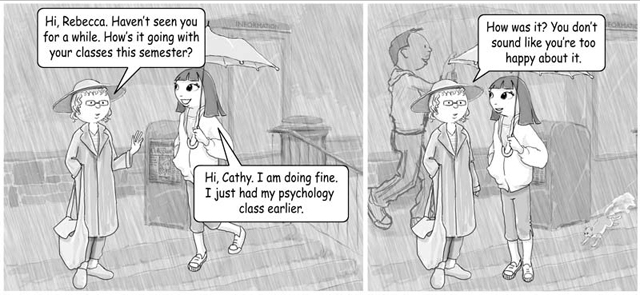
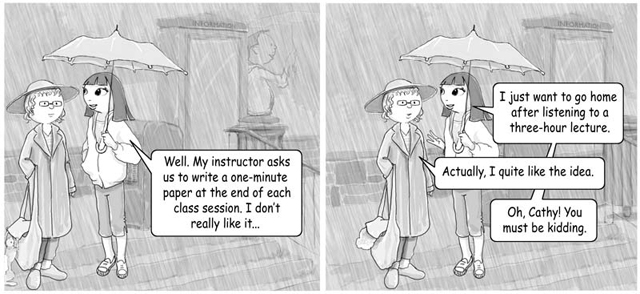
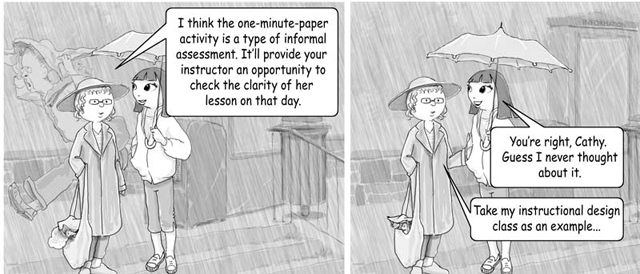
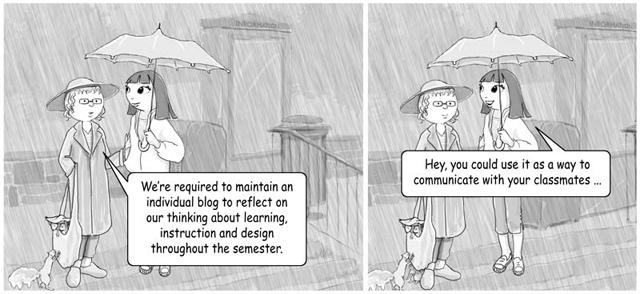
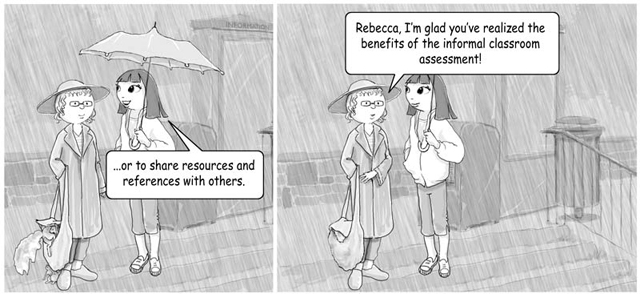
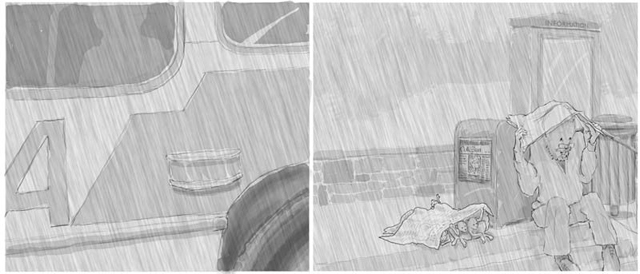
Informal assessment generally includes activities that can easily be incorporated into classroom routines. They can be used at anytime without interfering with instructional time. Informal assessment gives you an idea of how much you understand the material and seeks to identify your strengths and needs without regard to grade or age norms.
Concept Mapping
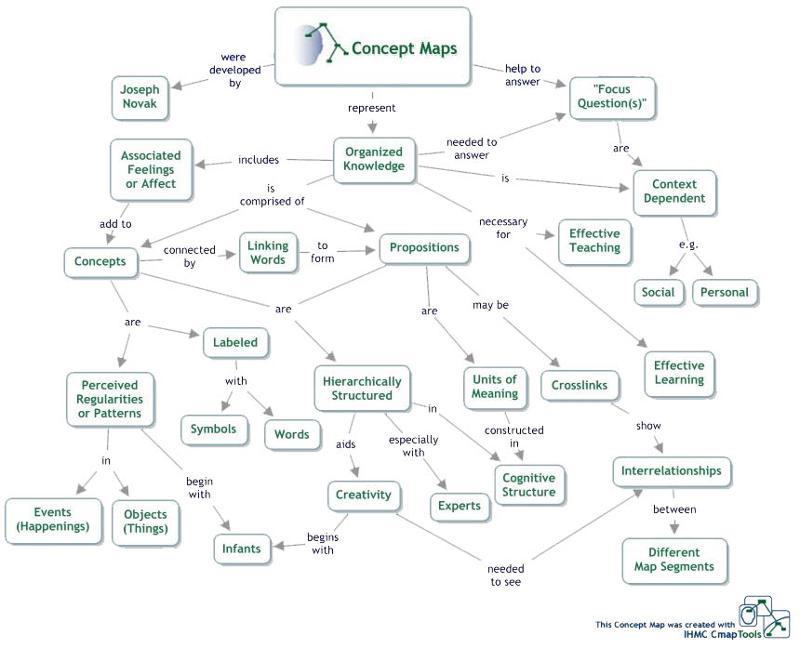 A concept map is a diagram made up of nodes or cells containing a concept, item, or question, as well as labeled links. They show the relationships between ideas and concepts, resulting in a graphical representation of knowledge. Concept maps can be used for brainstorming and communicating complex ideas.
A concept map is a diagram made up of nodes or cells containing a concept, item, or question, as well as labeled links. They show the relationships between ideas and concepts, resulting in a graphical representation of knowledge. Concept maps can be used for brainstorming and communicating complex ideas.
As an assessment tool, concept maps are often used to evaluate your understanding of complex relationships. The more you know about a topic, the more complex your map will be. Concept maps can also be used as a study tool to help you identify how concepts fit together and then evaluate where you have gaps in knowledge.
For more information on concept maps, check out the Concept Mapping iStudy tutorial.
Minute Papers
In a basic minute paper, the instructor takes the last minute of class and asks you to write down short answers to one or two questions. For example:
- What was the most important point made in class today?
- What was least clear in this lecture?
- What unanswered questions do you still have?
Minute papers help instructors assess what you have learned during a given class. When used for feedback, minute papers aren't usually graded and may even be submitted anonymously. Sometimes minute papers serve the dual purpose of collecting feedback and taking class attendance, in which case they wouldn't be anonymous.
The best way to prepare for a minute paper is to pay attention in class, take good notes, and, as material is presented, note any questions you may have. If your instructor uses a minute paper, it means he or she is interested in knowing what you understand from the material presented. Don't be afraid to let your instructor know which concepts in the day's presentation confused you. Your instructor will adapt his or her teaching based on your responses. That is, he or she may re-teach concepts that you are still unclear about and/or not spend any more time on concepts that the class clearly understands already. Thus, completing these assignment can honestly only help you.
Discussion Boards/Blogs/Wikis
Discussion boards, blogs, and wikis are all electronic, text-based, Web-based communication spaces. When used for assessment, students are usually expected to write about specific class-related topics and interact and discuss those topics with each other using the electronic space. The instructor should provide information about how the discussions will be graded. Assessment criteria often includes how many posts a you have made, how many times you replied to other posts, the quality of the posts you made, and how well you contribute to developing the discussion. Depending on the class, grammar, punctuation, spelling, sentence structure, and other writing skills may also be part of the assessment.
You will most likely need to plan some time to learn how to use the discussion board, blog, or wiki. Using a word processor to plan, organize, and develop your posts prior to entering them into the discussion board, blog, or wiki is also recommended. Just like any other assessment, you will need to review the class materials, organize your notes, and organize your thoughts in advance.
Discussion Board Rubrics
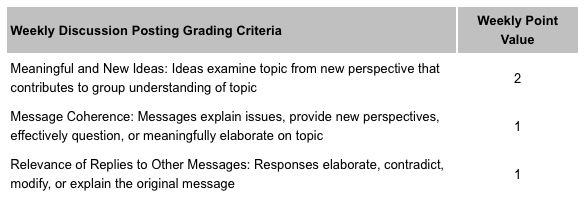 Rather than being a form of assessment, a rubric is a set of criteria and standards linked to learning objectives that is used to assess a student's performance on papers, projects, essays, and other assignments. A rubric consists of a set of scoring criteria and point values associated with those criteria. In most rubrics the criteria are grouped into categories so the instructor and the student can discriminate among the categories by level of performance. Each level of performance is given a numeric value which, when totaled, is associated with a grade.
Rather than being a form of assessment, a rubric is a set of criteria and standards linked to learning objectives that is used to assess a student's performance on papers, projects, essays, and other assignments. A rubric consists of a set of scoring criteria and point values associated with those criteria. In most rubrics the criteria are grouped into categories so the instructor and the student can discriminate among the categories by level of performance. Each level of performance is given a numeric value which, when totaled, is associated with a grade.


